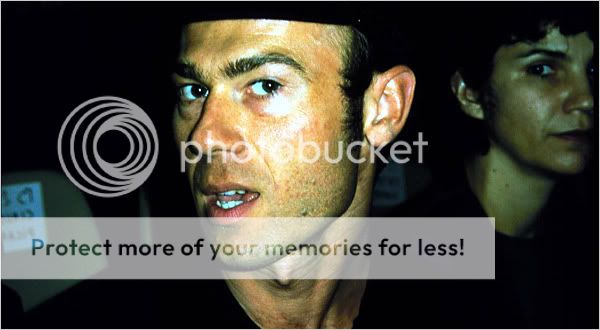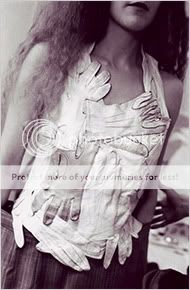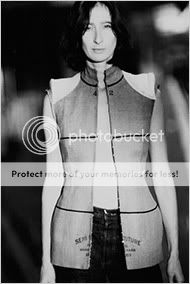DosViolines
far from home...
- Joined
- Aug 21, 2005
- Messages
- 3,212
- Reaction score
- 12
nytimes

NOW YOU SEE HIM Martin Margiela, circa 1997.
By ERIC WILSON
Published: October 1, 2008
Paris
ON Monday night at Martin Margiela’s runway show, an event that marked the 20th anniversary of one of the most influential and enigmatic designers on the global fashion stage with a collection based on the highlights of his career, Mr. Margiela, as is his custom, was nowhere to be seen.
An anomaly in an industry that places enormous value on the image and accessibility of its personalities, Mr. Margiela has maintained an astonishing elusiveness. He refuses to grant face-to-face interviews and has rarely been photographed, a provocative stance intended to emphasize two dogmatic principles: first, that Mr. Margiela’s designs, as confounding as they may be, should speak for themselves; and, second, that the work he shows is inherently the product of a collaborative team, not one person.
Hence, he does not take a bow at his shows, and all correspondence from his atelier here is traditionally written in the plural form with the signature “Maison Martin Margiela.”
This policy has led Mr. Margiela to be called fashion’s invisible man. His influence, perhaps as great as that of any living designer, is less often questioned than is his very existence.
Over the last year, however, the significance of Mr. Margiela as a living, breathing person — albeit ultimately unknowable — has taken on a new dimension. He has told colleagues that he wants to stop designing and that he has begun a search for his successor at the house.
Early this year, Mr. Margiela, 51, approached Raf Simons, another well-regarded Belgian designer who at the time was renegotiating his contract with Jil Sander, proposing that Mr. Simons take over the collection, according to associates of the designers. But nothing came of the conversation, and this fall Mr. Simons agreed to a three-year contract renewal with Jil Sander.
On Monday, Renzo Rosso, the chief executive of Diesel Group, which acquired Margiela’s business in 2002, added to the speculation that Mr. Margiela had not been involved in recent collections when The International Herald Tribune published this quotation from him: “We are very happy with Martin, but for a long time he has a strong team and does not work on the collection, just special projects.”
After the show on Monday, Mr. Rosso would not clarify Mr. Margiela’s role, but said that the company was working with a headhunter to find a designer “to complete our team.” Asked if Mr. Margiela was leaving, he said: “Never say never, but I cannot imagine. I love him.”
Mr. Margiela’s importance was obvious at the anniversary show, which included renditions of his great and witty conceptual designs: coats made of synthetic wigs, bodysuits that fused parts of trench coats and tuxedo jackets, and mirrored tights made to look like disco balls. But his impact is even more obvious on the designers he has influenced, including Marc Jacobs, Alexander McQueen and everyone else who showed pointed shoulders this season. Azzedine Alaïa recently called Mr. Margiela the last individual vision.
A graduate of Belgium’s Royal Academy of Fine Arts and a former assistant to Jean Paul Gaultier in Paris, Mr. Margiela was among a group of designers from Antwerp who caused a shift in fashion in the late ’80s by tearing apart and reassembling garments at the seams, introducing techniques that would have a lasting impact on everything from streetwear to haute couture. The acceptability of shredded jeans, for example, owes a debt to Mr. Margiela. But he has worked with such anonymity that only dedicated fashion consumers instantly recognize his name.
“Martin’s influence in fashion has been quite vast,” said Kaat Debo, the artistic director of the ModeMuseum, or MoMu, in Antwerp, where a retrospective of Mr. Margiela’s work opened this month. “Often what you see in the mainstream today is something that Martin introduced 20 years ago, and in a shocking way. For example, the showing of unfinished clothes with frayed hems or seams on the outside, which he did years ago, are things today that are seen as quite normal.”
Mr. Margiela’s runway shows have been alternately electrifying or humorous or sexy or just plain weird, as when he introduced a hooflike shoe in 1992 that has since become a Margiela signature. More recently, he presented a pair of $600 sunglasses that look like a censor bar. He has shown coats reconstructed with a sock at the elbow or sleeves protruding from the front and back; jackets with the sleeves turned inside out into capes; and, in 1994, an entire collection based on what Barbie’s wardrobe would look like if it were blown up to life size.
“It is a brilliant way of rethinking clothes with a very simple strategy,” said Harold Koda, the chief curator of the Costume Institute at the Metropolitan Museum of Art. “There is a weird tension that he throws into the clothes that is poetic, but it can also be unnerving in that it pushes you a little further. It’s not just pretty or simple clothing. It’s something that challenges you, even subliminally.”
Only in recent years has Mr. Margiela’s work become widely appreciated, in part because of the expansion of his brand by Diesel, which opened more stores and introduced things like sunglasses and a fragrance planned for next year. Roughly $80 million worth of products were sold internationally last year, according to the company.
But the changes also caused friction. Current and former employees have mentioned Mr. Margiela’s displeasure at Diesel’s marketing-driven culture, which would seem at odds with his philosophy that requires his fans to make an effort to find his clothes. Before the acquisition, the maison had not even been listed in the phone directory, nor had his name appeared on his collections or outside his shops.
The original labels consisted of a series of numbers printed on a white rectangle, attached with four white stitches that were left exposed on the outside of a garment. One number is circled to indicate, for example, women’s wear (1), men’s wear (10) or shoes (22). But this season, Diesel said it would introduce tailored suits signed Maison Martin Margiela, another reason several associates said Mr. Margiela wanted to leave.
At the Margiela atelier, in a former schoolhouse here in the 11th arrondissement, everything is shrouded in a lightly scuffed white fabric, including the furniture, walls and even staff members, who wear uniform lab coats that have the unsettling effect of eliminating a sense of the individual. (Mr. Margiela also traditionally veils the faces of models at his shows.) Several current and former employees described an environment where ideas flow freely and ownership of design is shared by all. Yet there is also a sense that the vision stems directly from Mr. Margiela.
“You can imagine, if you don’t know anything about him, that he is this antisocial, cold person, but he is not that way at all,” said Stella Ishii, the owner of The News showroom in Manhattan, which distributed his collections in the United States for many years. “He is a very warm and sensitive person.”
Many people have seen him, and in fact longtime store buyers and editors often recognize him sitting in the audience at his shows. Tall and classically handsome, he wears his own version of a uniform, often a tight black sweater in the winter or a T-shirt in summer, with Levi’s and a dark cap pulled down low over his eyes. At the atelier, Ms. Ishii recalled, he would explain his collections with passion and intellect, even demonstrating the techniques, and at the shows, he was always backstage, styling everything himself.
“He is a man of substance in a world of appearance,” said Deanna Ferretti, who founded the esteemed Italian knitwear company Miss Deanna in the ’60s and worked with Mr. Margiela in developing sweaters. At the beginning of his career, he asked Ms. Ferretti to make a sweater with elbows, breasts and other traces of the body, “as if someone’s grandmother had worn it hundreds of times, as if someone had found it years later in some attic,” she recalled. It took years to research yarns that could be molded under heat, and she eventually persuaded an automotive factory to let her use an industrial oven to cook the oversize sweater on a huge test dummy. They made only 1,000 sweaters.
His decision to cloak himself in fashion’s shadows was made several years after Mr. Margiela formed his company with Jenny Meirens, a Brussels retailer, in 1988. He answered some reporters’ questions and was photographed until the mid-’90s, when, in reaction to the growing celebrity culture that had given rise to supermodels and designers who were household names, he suddenly stopped talking.
Patrick Scallon, who as the director of communications was the most visible face of the house for 16 years until he resigned last October, said that Mr. Margiela believes customers should react to the clothes and the philosophy, not the news media hype.
“There is a lot of revisionist history now in that people think of what Martin Margiela did as a marketing ploy,” Mr. Scallon said. “It was not just for the sake of being provocative. A designer is not an artist in a gallery, not a sculptor with a chisel and stone in a garden. He is someone who has to work with a collaborative team. The downside is that it engendered these rumors that he doesn’t exist or doesn’t work.”
It is remarkable, Ms. Debo noted, that in the news media coverage surrounding the Margiela exhibition in Antwerp, more than half of the articles asked, “Who is Martin Margiela?” In the ’90s, as Mr. Margiela developed a loyal following, his silence created great curiosity, but also a mix of resentment from magazines that refused to cover his collections because the designer would not meet with editors, and respect from those who admired his position.
“It was a different time,” Mr. Scallon said. “People were open to being provoked and wanted their buttons pushed. That chapter isn’t there anymore.”
In fashion, it has become almost a cliché for critically acclaimed designers to sell their businesses to big fashion conglomerates, then chafe at the changes ordered up by the new owner. Helmut Lang, Ms. Sander and Tom Ford are the most obvious examples of designers who have resigned over such creative control issues. In Mr. Margiela’s case, his interest in leaving may have as much to do with a desire to enjoy his life outside the insistent glare of the fashion world, his associates said.
“Martin Margiela has always been capable of prioritizing his private life,” Mr. Scallon said, noting that although he had heard the rumors, he was not convinced that Mr. Margiela would step down. “But I have been happy and proud to work with somebody who I know is capable of understanding when he doesn’t have anything more to say.”





